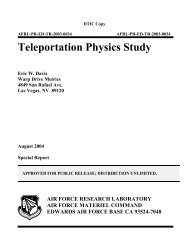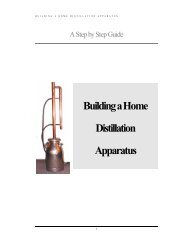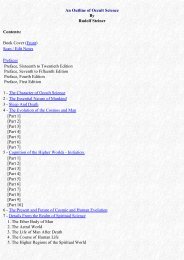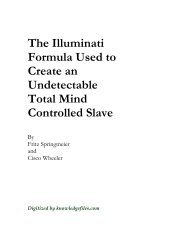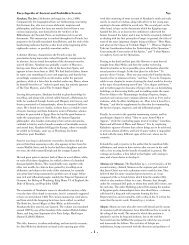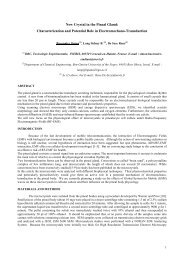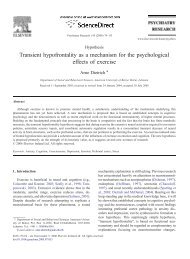Journal of Environmental Radioactivity - onPrincipleAlone
Journal of Environmental Radioactivity - onPrincipleAlone
Journal of Environmental Radioactivity - onPrincipleAlone
- No tags were found...
Create successful ePaper yourself
Turn your PDF publications into a flip-book with our unique Google optimized e-Paper software.
4G. Lujanien_e et al. / <strong>Journal</strong> <strong>of</strong> <strong>Environmental</strong> <strong>Radioactivity</strong> xxx (2012) 1e10137Cs, µBq/m3120010008006004002000131 IR = 0.69 (n= 29)0 2000 4000 6000 80007Be, µBq/m 3137 CsR = 0.75 (n=29)4000300020001000Fig. 3. 137 Cs and 131 I activity concentrations plotted against the 7 Be activity concentrationin aerosol samples collected during the Fukushima plume episode.(e.g. Lujanas and Lujanien_e, 2007). An increase in the 7 Be activityconcentrations in summer and autumn season was explained bya vertically downward transport within the troposphere (Kochet al., 1996) and by a stratosphere-troposphere exchange (Jordanet al., 2003; Land and Feichter, 2003). The high 7 Be activityconcentrations in the surface air were also interpreted by thedownward and upward atmospheric flows in the tropospherecaused by a pair <strong>of</strong> travelling anticyclone and extra tropical cyclonethat passes over Japan in spring and autumn with a period <strong>of</strong> a fewdays (Yoshimori, 2005). It was supposed that the air <strong>of</strong> lowtemperature flows downward from convergence in the Rossbywaves to divergence in the surface anticyclone, and the warm airmoves upward from convergence in the surface cyclone to divergencein the Rossby waves. In these studies an increase in theactivity concentrations in the near-surface atmosphere was associatedwith downward movements <strong>of</strong> air masses. Thus, the positivecorrelation between the anthropogenic radionuclides and 7 Be(Fig. 3) can be an indication <strong>of</strong> their arrival from the upper layers <strong>of</strong>the troposphere.On the other hand, short-lived radon decay products, such as theterrigenous 210 Pb, 212 Pb and 214 Pb can also be used as atmospherictracers to study air masses transport (Sheets and Lawrence, 1999).The main source <strong>of</strong> 212 Pb (half-life <strong>of</strong> 10.6 h) in the air is 220 Rn (halflife<strong>of</strong> 54 s) exhalation from the earth’s surface, therefore 212 Pbactivity concentrations reflect local conditions (at height <strong>of</strong> about1 km), contrary to 222 Rn (half-life <strong>of</strong> 3.82 d) progenies 214 Pb(half-life <strong>of</strong> 26.8 min) and 210 Pb (half-life <strong>of</strong> 22.3 y). The residencetimes <strong>of</strong> radon decay products in the ambient air were estimated tobe similar to that <strong>of</strong> 7 Be (about 8 days). About 76% <strong>of</strong> the 214 Pbactivity and 67% <strong>of</strong> the 212 Pb activity were usually associated withaerosol particles in the 0.08e1.4-mm size range, though a small shiftin the aerosol size distribution was observed for214 Pb(Papastefanou, 2009). Seasonal variations <strong>of</strong>212 Pb and 210 Pbisotopes were found to be distinctly different in the lower atmospherewhile the behaviour <strong>of</strong> 214 Pb was similar to that <strong>of</strong> 210 Pb. Itwas concluded therefore that airborne concentrations <strong>of</strong> 212 Pb,contrary to those <strong>of</strong> 210 Pb could be strongly influenced by localemissions (Sheets and Lawrence, 1999). This behavior and shift inthe size distribution can be attributed to the variation in half-lives<strong>of</strong> Pb isotopes and their parents. Both parents are gaseous speciesbut their different half-life under particular local conditions such asexhalation, mixing height and intensity can result in their variousvertical and horizontal transports.222 Rn <strong>of</strong> longer half-life hasa higher potential to be more widely distributed vertically andhorizontally. On the other hand, due to different half-lives <strong>of</strong> Pbisotopes, they can serve for indication <strong>of</strong> events occurring on0131I, µBq/m 3different time scales. Kownacka (2002) reported that activityconcentrations <strong>of</strong> 210 Pb were almost constantly distributed above1 km, and did not decrease with altitudes. An increase in 210 Pb andother natural radionuclide concentrations in the stratosphere wasalso observed after the large volcanic eruptions. Abe et al. (2010)showed that distributions <strong>of</strong> the 7 Be and 210 Pb nuclides wereuniform in the range <strong>of</strong> a few hundred kilometers in the horizontaldirection and up to w1 km height, whereas 212 Pb activity concentrationsvaried greatly depending on the geographical location andaltitude <strong>of</strong> the observation site. The recent studies indicateda similar behavior <strong>of</strong> 7 Be and 210 Pb, and that they cannot be used asindependent tracers to study atmospheric processes. Although thebehavior <strong>of</strong> 212 Pb and 214 Pb is not fully understood yet, they can beused as independent atmospheric traces. A weak correlation wasfound in 7 Be and 212 Pb records (0.39), while no correlation wasobserved for 7 Be and 214 Pb ( 0.16), indicating different sources <strong>of</strong>Pb isotopes. The 212 Pb and 214 Pb records may therefore indicatedifferent atmospheric processes. Most probably 212 Pb is an indicator<strong>of</strong> horizontal transport at lower heights (up to 1 km),however, a weak correlation showed that this transport waslimited. On the other hand, 214 Pb represents short time events atour site. An increase in the activity ratios <strong>of</strong> 7 Be/ 212 Pb and 7 Be/ 214 Pb,accompanied by an increase in 137 Cs and 131 I activity concentrationsobserved during the studied period may indicate that the dominantsource <strong>of</strong> Fukushima originated radionuclides at our site was athigher altitudes. Therefore, an increase in the 7 Be/ 212 Pb and7 Be/ 214 Pb activity ratios in this case can be used for an indication <strong>of</strong>the downward air mass transport.The activity concentration <strong>of</strong> 137 Cs as well as the 134 Cs/ 137 Cs,7 Be/ 212 Pb and 7 Be/ 214 Pb activity ratios in aerosol samples in thestudied episode after the Fukushima accident are presented inFig. 4. The 134 Cs/ 137 Cs activity ratio in Vilnius was close to 1 (N ¼ 30,Mean ¼ 0.782, S.D. ¼ 0.345, Median ¼ 0.938). In samples collectedon 24 March, and from 26 to 27 March, the activity concentration <strong>of</strong>134 Cs was below the detection limit. In the most active samplecollected on 3e4 April the 134 Cs/ 137 Cs activity ratio was equal to1.00 0.05.Fig. 5 shows the wind speed and wind vectors indicating the jetstream at 500 hPa for 24e25 March which affected the transport <strong>of</strong>the Fukushima plume to Europe. The strong meanders on the jetstream resulted in the downward air mass transport, as it is indicatedby an increase in the 7 Be activity concentrations (Fig. 2), aswell as by an increase in the activity ratios <strong>of</strong> 7 Be/ 212 Pb and7 Be/ 214 Pb (Fig. 4). A similar increase in the activity concentrations <strong>of</strong>131 I,137 Cs and 7 Be, together with enhanced activity ratios <strong>of</strong>7 Be/ 212 Pb and 7 Be/ 214 Pb observed on 23, 24, 27 and 31 March, as137Cs µBq/m310001001010.1137 Cs7 Be/ 212 Pb134Cs/ 137 Cs7 Be/ 214 Pb24 26 28 30 1 3 5 7 9 11 13March April 20111001010.10.01Fig. 4. Activity concentration <strong>of</strong> 137 Cs and 134 Cs/ 137 Cs, 7 Be/ 212 Pb and 7 Be/ 214 Pb activityratios in aerosol samples in Vilnius in 2011.Ratio <strong>of</strong> radionuclidesPlease cite this article in press as: Lujanien_e, G., et al., Radionuclides from the Fukushima accident in the air over Lithuania: measurement andmodelling approaches, <strong>Journal</strong> <strong>of</strong> <strong>Environmental</strong> <strong>Radioactivity</strong> (2012), doi:10.1016/j.jenvrad.2011.12.004



